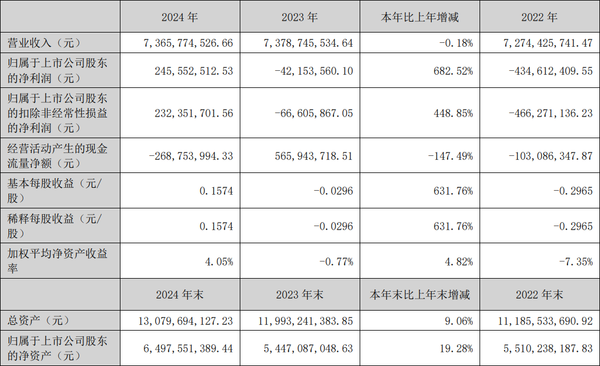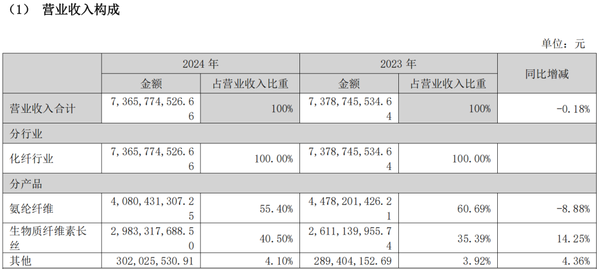Soaring 682%! Bio-based fiber leader to boost capacity to 130,000 tons!

Main Operating Data
As the global leader in biomass cellulose filament production capacity, Xinxiang Chemical Fiber's biomass cellulose filament capacity reached 100,000 tons in 2024, with a capacity utilization rate of 96.37% and a sales ratio exceeding 85%. The domestic export ratio is 46.38%, firmly ranking first in the industry. Its products are widely sold in markets such as India, Pakistan, Turkey, and Europe.

Revenue Composition
Technologically, the company has realized a full industrial chain closed loop "from grass to clothing" by using mushroom grass fiber, replacing traditional wood pulp with mushroom grass pulp, reducing costs by 15%, and achieving an annual production capacity of 12,000 tons. The DT solvent method for recycling waste textiles can recycle more than 20% of waste cotton fabrics, reducing reliance on raw materials and environmental pressure.
In terms of R&D investment, the company invested 301 million yuan throughout the year, a year-on-year increase of 11.66%, accounting for 4.08% of revenue. It focuses on the layout of differentiated products such as flame-retardant and intelligent temperature-regulating fibers, which have entered testing in military and medical fields, with commercialization expected by 2025. The patent reserves cover the entire process of bio-based materials, with a total of 103 utility model patents and 24 invention patents.
In addition, the company is accelerating its transformation to ultra-fine denier spandex fiber, with the third phase of the 100,000-ton project now in operation, targeting the high-end sportswear market. It has also launched a 30,000-ton biomass fiber project in Xinjiang, planning to increase total bio-based production capacity to 130,000 tons by 2025. The overseas market is performing strongly, with European orders growing by 32%. A factory in Turkey is planned to circumvent trade barriers, with the goal of increasing overseas revenue to account for over 30% by 2025.
Looking ahead to 2025, the company has set a revenue target of 7.8 billion yuan (a year-on-year increase of 6%), with the bio-based fiber business expected to contribute over 45%. Plans include investing 1.5 billion yuan in upgrading the grass fiber production line and developing 3D printing materials. Risk factors include dependence on pulp imports, fluctuations in spandex prices, and rising overseas freight costs. Xinxiang Chemical Fiber, focusing on bio-based fibers, aims to achieve explosive profit growth through technological breakthroughs and capacity expansion amid the green transformation wave. Its "full industry chain + circular economy" model may set a new benchmark for the industry.
【Copyright and Disclaimer】The above information is collected and organized by PlastMatch. The copyright belongs to the original author. This article is reprinted for the purpose of providing more information, and it does not imply that PlastMatch endorses the views expressed in the article or guarantees its accuracy. If there are any errors in the source attribution or if your legitimate rights have been infringed, please contact us, and we will promptly correct or remove the content. If other media, websites, or individuals use the aforementioned content, they must clearly indicate the original source and origin of the work and assume legal responsibility on their own.
Most Popular
-

List Released! Mexico Announces 50% Tariff On 1,371 China Product Categories
-

Nissan Cuts Production of New Leaf EV in Half Due to Battery Shortage
-

New Breakthrough in Domestic Adiponitrile! Observing the Rise of China's Nylon Industry Chain from Tianchen Qixiang's Production
-

Dow, Wanhua, Huntsman Intensively Raise Prices! Who Controls the Global MDI Prices?
-

Mexico officially imposes tariffs on 1,400 chinese products, with rates up to 50%






